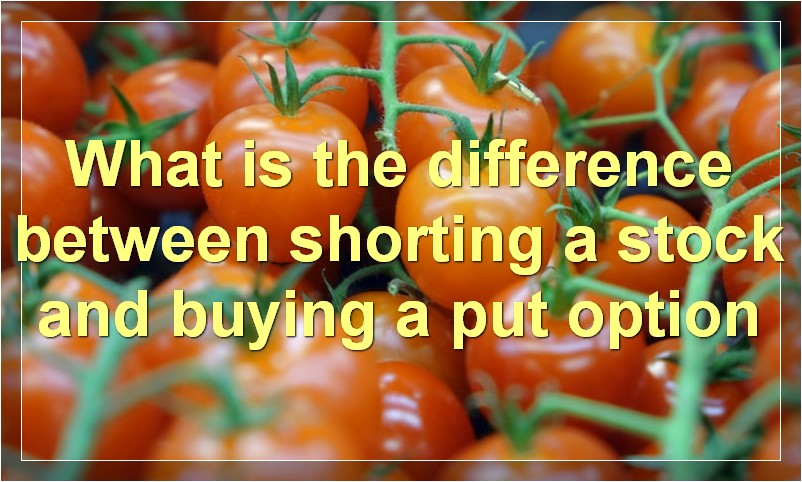If you’re looking to make a quick buck, shorting stocks may be the way to go.
What is a short position in stocks
When you short a stock, you’re betting that the price will go down.
If you’re right, you make money. If you’re wrong, you lose money.
It’s that simple.
But what exactly is a short position?
A short position is when you sell a security you do not own and hope to buy the same security back at a lower price so you can have a profit.
For example, let’s say you think Company XYZ’s stock is overvalued at $10 per share. You could open a short position by selling 100 shares of Company XYZ at $10 per share.
Then, if the stock price falls to $8 per share, you could buy the shares back and close out your position. Since you sold the shares for $10 and bought them back for $8, you would have made a profit of $200.
Of course, if the stock price had risen to $12 per share, you would have lost money.
Shorting stocks is riskier than buying stocks because there is no limit to how high the stock price can go. If you buy a stock at $10 per share and it goes to $0, you’ve lost $10 per share. But if you short a stock at $10 per share and it goes to $20, you’ve lost $10 per share. And if it goes to $30, you’ve lost $20 per share, and so on.
How do you short a stock

When you short a stock, you are selling it with the hope that the price will go down so that you can buy it back at a lower price and pocket the difference. To do this, you borrow shares of the stock from somebody else and sell them, hoping to buy them back later at a lower price. If the price falls as you expect, you can buy the shares back and return them to the person you borrowed them from, pocketing the difference. If the price rises, however, you will have to buy the shares back at a higher price and return them to the person you borrowed them from, losing money in the process.
There are a few things to keep in mind when shorting a stock. First, because you are selling a stock that you do not own, you will have to pay any dividends that are paid out on that stock. Second, if the price of the stock goes up instead of down, you could lose a lot of money. Finally, because you are borrowing shares from somebody else, you will have to pay interest on the loan.
Shorting a stock can be a risky proposition, but if done carefully it can be a lucrative one.
What is the difference between a long and short position in stocks
There are two types of positions that can be taken when investing in stocks: long and short. A long position is where the investor buys shares of a stock with the hope that the price will go up so they can sell it at a profit. A short position is just the opposite – the investor sells shares of a stock they do not own, hoping the price will go down so they can buy it back at a lower price and make a profit.
There are a few key differences between long and short positions in stocks. First, with a long position, the investor has to pay the full price of the shares upfront. With a short position, the investor only needs to put up enough money to cover any potential losses if the stock price goes up. Second, a long position exposes the investor to more risk since the price could potentially go down and they would still need to pay the full price for the shares. A short position has less risk since the most an investor could lose is what they put up initially to cover any potential losses.
Overall, taking a long or short position in stocks is a matter of personal preference and investment strategy. Some investors prefer to take a more risky approach with their investments by taking long positions, while others prefer to play it safe by taking short positions. It ultimately depends on what the investor is comfortable with and what their goals are.
What are the benefits of shorting a stock
There are two main benefits to shorting a stock:
1. You can make money if the stock price falls.
2. It provides hedging opportunities against long positions in the same stock or other stocks in the same sector.
What are the risks of shorting a stock
When you short a stock, you are essentially betting that the stock price will go down. If the stock price goes up, you will lose money. There is also the risk that the company whose stock you are shorting will go bankrupt, which would mean that you would lose all of your investment.
What is the difference between shorting a stock and buying a put option

When it comes to investing, there are a lot of different strategies that you can use in order to make money. One of these strategies is shorting a stock. Shorting a stock means that you are selling a security that you do not own and hope to buy the same security back at a lower price so that you can pocket the difference. Another strategy that you can use is buying a put option. A put option gives you the right, but not the obligation, to sell a security at a specified price within a certain time frame. So, what is the difference between shorting a stock and buying a put option?
Shorting a stock is riskier than buying a put option because you are counting on the stock price going down in order for you to make money. With a put option, you will still make money if the stock price goes down, but you are not as exposed to the downside risk. Put options are also less expensive than shorting a stock, so they may be a better option for those with limited capital.
What is the difference between shorting a stock and selling a call option
There are a few key differences between shorting a stock and selling a call option. For one, when you short a stock, you are borrowing shares from someone else and selling them, with the hope that the price will drop so you can buy them back at a lower price and return the shares to the lender. With a call option, you are selling the right for someone else to buy a stock at a certain price within a certain time frame. If the stock price does not reach the strike price by the expiration date, then you keep the entire premium.
Can you make money if the stock price goes down
Many people believe that you can only make money in the stock market if the stock prices are going up. However, this is not always the case. You can actually make money even when the stock prices are going down, as long as you know what you are doing.
There are a few different ways to make money when the stock prices are going down. One way is to short sell. This is when you sell a security that you do not own and hope to buy it back at a lower price so you can have a profit. Another way to make money is to buy put options. This gives you the right to sell a security at a certain price, no matter how low the stock price goes.
If you are knowledgeable about the stock market and know what you are doing, then you can actually make a lot of money even when the stock prices are going down.
How do you make money from shorting a stock
When you short a stock, you are essentially betting that the stock price will go down. If the stock price does indeed go down, you will make a profit. To short a stock, you first need to borrow shares of the stock from somebody else. Then, you sell the stock. If the price falls, you buy it back at the lower price and return the shares to the person you borrowed them from. The difference between the price at which you sold the stock and the price at which you bought it back is your profit.
What happens if the stock price goes to zero when you are short
If the stock price goes to zero when you are short, you will be able to buy the stock at a price of zero and then sell it at the market price, making a profit.

